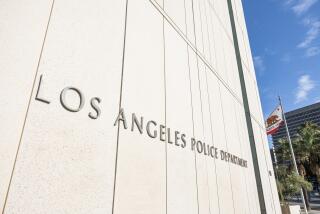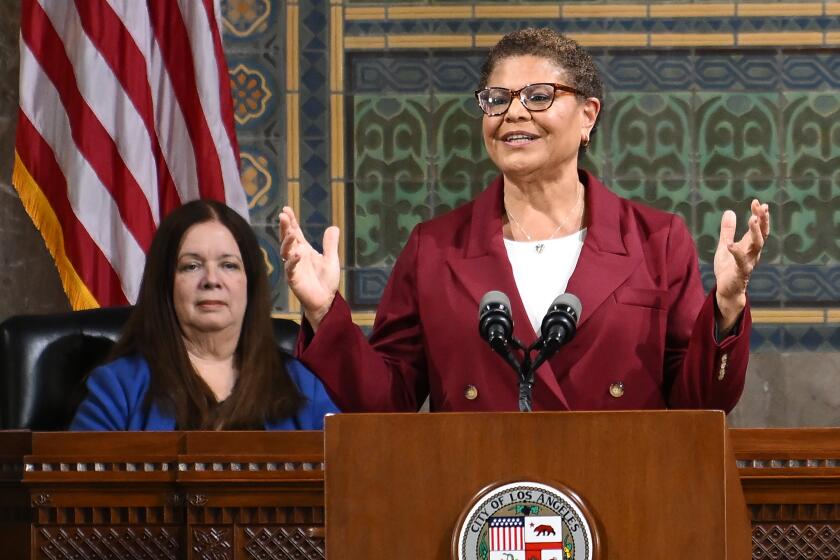Police-Community Rift
- Share via
Los Angeles police sergeant Robert J. Thoms, formerly a “community relations” officer, has gone into the intelligence business and has testified before a U.S. Senate subcommittee about what he considered subversive and violent organizations.
As a community relations officer from March 26, 1967 to Feb. 11 1968, Sgt. Thoms worked with many of the barrio and ghetto organizations which, if nothing else, understand the problems of people who do not relate to, much less participate in, the mainstream of American life.
Thoms gained the confidence of leaders in the barrios and ghettos who felt there was still hope for at least a working relationship between frustrated and disadvantaged communities and the equally frustrated but relatively powerful police force.
After working for a year in this sensitive area, Sgt. Thoms was transffered by the police department to intelligence work.
The next time the communities, which had known Sgt. Thoms as a community relations officer, heard from him was as an an intelligence officer testifying before a U.S. Senate subcommittee investigating subversive and violent organizations.
Sgt. Thoms told the subcommittee chaired by Sen. Thomas J. Dodd that “the organizations in Los Angeles that are considered to be violent and subversive in nature are: Ron Karenga’s US, the Black Congress, the Black Panther Party, the Friends of the Panthers, and the Brown Berets.
In the 59-page report, however, Sgt. Thoms also touches upon such diverse organizations as the Ford Foundation, the League of United Citizens to Help Addicts, the Episcopal Diocese of Los Angeles, the UCLA Industrial Relations Commission and the East Los Angeles Community Union.
Nowhere does Sgt. Thoms say that these organizations are subversive or violent but he leaves the clear impression that they are somehow unsavory. J.G. Sourwine, the subcommittee’s chief counsel, asked Thom, for example, why the sergeant had mentioned the Los Angeles Community Union.
“Is the organization a violent on?” Sourwine asked.
“No, sir,” answered Thoms.
“Perhaps I do not follow you.” press Sourwine. “Why is it brought out here?”
To this Sgt. Thoms answered: “Just as an example of the umbrella organizations we deal with which will contain some good intentioned organizations to give it an air of respectability.”
On page 22, Sgt. Thoms tells the subcommittee that “Next I would like to with the federal funding of various organizations in the Los Angeles area.”
Sourwine: “Funding subversive and violent organizations?”
Thoms: “Yes, sir.”
Sourwine: “Go ahead.”
Thoms: “One program known as the education opportunities program (EOP) for the California State College of Los Angeles, was funded in 1968 in the amount of $250,000 for 123 students.”
After explaining that the money was used to give minority students “a monthly stipend for attending school and also used for books and a place to live,” Sgt. Thoms said: “I can document that there are 43 students (of the 123 students receiving EOP funds, presumably) attending Cal State College at Los Angeles that belong to militant organizations in Los Angeles.”
Perhaps the most revealing part of the Thoms testimony is when Chief Counsel Sourwin asks Thoms whether his information was gathered from a reliable source. Yes, answer Thoms, “the report was made public in May in Chicago.”
Who put the report out? asks Sourwine. “I made the report to a convention of the International Security Conference.”
Retorts Sourwine: “When I ask if it came from a source you believe to be reliable I am not surprised you said, ‘Yes.’”
Thom’s report should be read by all Americans concerned with the problem of the credibility gap.
More to Read
Sign up for Essential California
The most important California stories and recommendations in your inbox every morning.
You may occasionally receive promotional content from the Los Angeles Times.














